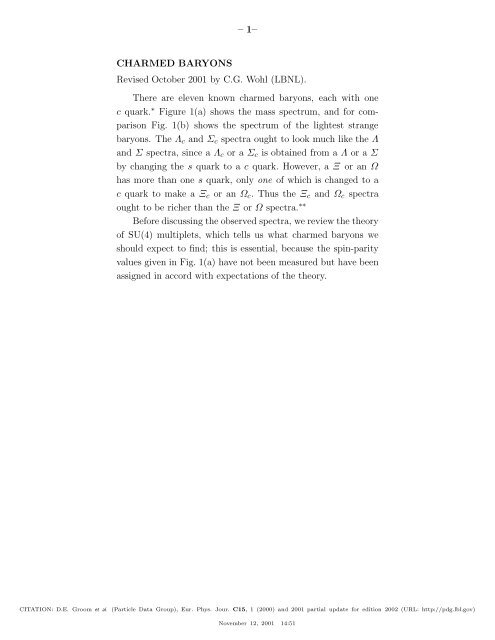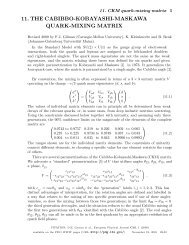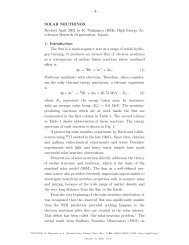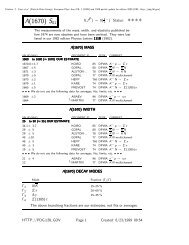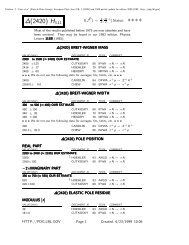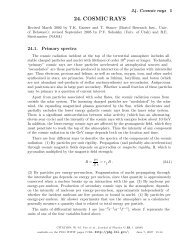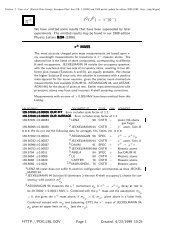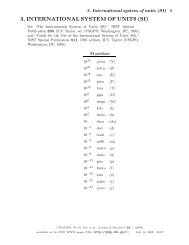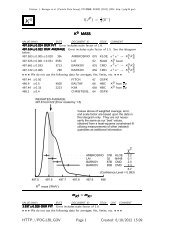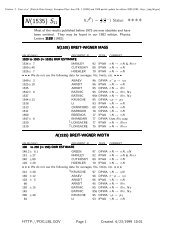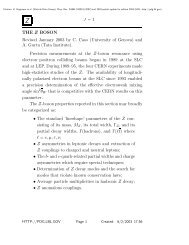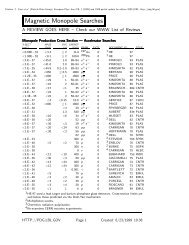Note on Charmed Baryons - Particle Data Group
Note on Charmed Baryons - Particle Data Group
Note on Charmed Baryons - Particle Data Group
You also want an ePaper? Increase the reach of your titles
YUMPU automatically turns print PDFs into web optimized ePapers that Google loves.
–1–<br />
CHARMED BARYONS<br />
Revised October 2001 by C.G. Wohl (LBNL).<br />
There are eleven known charmed bary<strong>on</strong>s, each with <strong>on</strong>e<br />
c quark. ∗ Figure 1(a) shows the mass spectrum, and for comparis<strong>on</strong><br />
Fig. 1(b) shows the spectrum of the lightest strange<br />
bary<strong>on</strong>s. The Λc and Σc spectra ought to look much like the Λ<br />
and Σ spectra, since a Λc or a Σc is obtained from a Λ or a Σ<br />
by changing the s quark to a c quark. However, a Ξ or an Ω<br />
has more than <strong>on</strong>e s quark, <strong>on</strong>ly <strong>on</strong>e of which is changed to a<br />
c quark to make a Ξc or an Ωc. ThustheΞc and Ωc spectra<br />
ought to be richer than the Ξ or Ω spectra. ∗∗<br />
Before discussing the observed spectra, we review the theory<br />
of SU(4) multiplets, which tells us what charmed bary<strong>on</strong>s we<br />
should expect to find; this is essential, because the spin-parity<br />
values given in Fig. 1(a) have not been measured but have been<br />
assigned in accord with expectati<strong>on</strong>s of the theory.<br />
CITATION: D.E. Groom et al. (<strong>Particle</strong> <strong>Data</strong> <strong>Group</strong>), Eur. Phys. Jour. C15, 1 (2000) and 2001 partial update for editi<strong>on</strong> 2002 (URL: http://pdg.lbl.gov)<br />
November 12, 2001 14:51
<strong>Charmed</strong> bary<strong>on</strong> mass (GeV)<br />
2.9<br />
2.7<br />
2.5<br />
2.3<br />
3/2 –<br />
1/2 –<br />
1/2 +<br />
ππ<br />
3/2 +<br />
1/2 +<br />
π<br />
3/2 +<br />
1/2 +<br />
1/2 +<br />
1/2 +<br />
–2–<br />
(a) <strong>Charmed</strong> bary<strong>on</strong>s (b) Light strange bary<strong>on</strong>s<br />
π<br />
π<br />
3/2 –<br />
1/2 –<br />
π<br />
γ<br />
π<br />
π<br />
0.6<br />
0.4<br />
0.2<br />
0.0<br />
Mass above baseline (GeV)<br />
Λ c Σ c Ξ c Ω c Λ Σ Ξ Ω<br />
Figure 1. (a) The known charmed bary<strong>on</strong>s, and (b) the<br />
lightest strange bary<strong>on</strong>s. Isospin splittings are not shown, and<br />
the <strong>on</strong>ly transiti<strong>on</strong>s shown are those between the charmed<br />
bary<strong>on</strong>s. <str<strong>on</strong>g>Note</str<strong>on</strong>g> that there are two J P =1/2 + Ξc states, and<br />
that the Ωc does not have J =3/2. Actually, n<strong>on</strong>e of the<br />
J P values of the charmed bary<strong>on</strong>s has been measured (except<br />
perhaps for the 1/2 + Λc), but they are all very likely as shown—<br />
see the discussi<strong>on</strong>.<br />
0.6<br />
0.4<br />
0.2<br />
0.0<br />
3/2 –<br />
1/2 –<br />
1/2 +<br />
November 12, 2001 14:51<br />
3/2 +<br />
1/2 +<br />
3/2 –<br />
3/2 +<br />
1/2 +<br />
3/2 +<br />
1.8<br />
1.6<br />
1.4<br />
1.2<br />
Strange bary<strong>on</strong> mass (GeV)
–3–<br />
SU(4) multiplets—Bary<strong>on</strong>s made from u, d, s, andcquarks<br />
bel<strong>on</strong>g to SU(4) multiplets. The multiplet numerology, analogous<br />
to 3×3×3 =10+81+82+1 for the subset of bary<strong>on</strong>s made<br />
from just u, d, andsquarks, is 4 × 4 × 4=20+20 ′ 1 +20′ 2 +¯4.<br />
Figure 2(a) shows the 20-plet whose bottom level is an SU(3)<br />
decuplet, such as the decuplet that includes the ∆(1232). Figure<br />
2(b) shows the 20 ′ -plet whose bottom level is an SU(3)<br />
octet, such as the octet that includes the nucle<strong>on</strong>. Figure 2(c)<br />
shows the ¯4 multiplet, an inverted tetrahedr<strong>on</strong>. One level up<br />
in each multiplet are the bary<strong>on</strong>s with <strong>on</strong>e c quark. All the<br />
bary<strong>on</strong>s in a given multiplet have the same spin and parity.<br />
Each N or ∆ or SU(3)-singlet-Λ res<strong>on</strong>ance calls for another<br />
20 ′ - or 20- or ¯4-plet, respectively.<br />
The flavor symmetries shown in Fig. 2 are of course very<br />
badly broken, but the figure is the simplest way to see what<br />
charmed bary<strong>on</strong>s should exist. For example, from Fig. 2(b), we<br />
expect to find, in the same J P =1/2 + 20 ′ -plet as the nucle<strong>on</strong>,<br />
a Λc, aΣc,two Ξc’s, and an Ωc. <str<strong>on</strong>g>Note</str<strong>on</strong>g> that this Ωc is not in the<br />
same SU(4) multiplet as the famous J P =3/2 + Ω − .<br />
November 12, 2001 14:51
Δ −<br />
Σ 0<br />
c<br />
Ξ + cc<br />
(a)<br />
Ω + cc<br />
Ω −<br />
Ω ++<br />
ccc<br />
,,,,,,,,,,,,,<br />
,,,,,,,,,,,,,<br />
,,,,,,,,,,,,,<br />
,,,,,,,,,,,,,<br />
,,,,,,,,,,,,,<br />
Σ c<br />
+<br />
Ξ ++<br />
cc<br />
–4–<br />
Σ ++<br />
c<br />
(b)<br />
Ξ + Ξ c<br />
0<br />
c<br />
Ξ 0<br />
Σ +<br />
Δ +<br />
Δ 0<br />
Σ −<br />
Ξ −<br />
,,,,,,,,,,,,,,,,,,,,,,,,,,<br />
,,,,,,,,,,,,,,,,,,,,,,,,,,<br />
,,,,,,,,,,,,,,,,,,,,,,,,,,<br />
,,,,,,,,,,,,,,,,,,,,,,,,,,<br />
,,,,,,,,,,,,,,,,,,,,,,,,,,<br />
,,,,,,,,,,,,,,,,,,,,,,,,,,<br />
,,,,,,,,,,,,,,,,,,,,,,,,,,<br />
,,,,,,,,,,,,,,,,,,,,,,,,,,<br />
,,,,,,,,,,,,,,,,,,,,,,,,,,,,,,,,,,,,,,<br />
,,,,,,,,,,,,,,,,,,,,,,,,,,<br />
,,,,,,,,,,,,,,,,,,,,,,,,,,,,,,,,,,,,,,<br />
,,,,,,,,,,,,,,,,,,,,,,,,,,<br />
,,,,,,,,,,,,,,,,,,,,,,,,,,,,,,,,,,,,,,<br />
,,,,,,,,,,,,,,,,,,,,,,,,,,<br />
,,,,,,,,,,,,,,,,,,,,,,,,,,,,,,,,,,,,,,<br />
,,,,,,,,,,,,,,,,,,,,,,,,,,<br />
,,,,,,,,,,,,,,,,,,,,,,,,,,,,,,,,,,,,,,<br />
,,,,,,,,,,,,,,,,,,,,,,,,,, Σ ,,,,,,,,,,,,,,,,,,,,,,,,,,,,,,,,,,,,,,<br />
,,,,,,,,,,,,,,,,,,,,,,,,,,<br />
,,,,,,,,,,,,,,,,,,,,,,,,,,,,,,,,,,,,,,<br />
,,,,,,,,,,,,,,,,,,,,,,,,,,<br />
,,,,,,,,,,,,,,,,,,,,,,,,,,,,,,,,,,,,,,<br />
,,,,,,,,,,,,,,,,,,,,,,,,,,<br />
,,,,,,,,,,,,,,,,,,,,,,,,,,,,,,,,,,,,,,<br />
,,,,,,,,,,,,,,,,,,,,,,,,,,,,,,,,,,,,,,<br />
,,,,,,,,,,,,,,,,,,,,,,,,,,,,,,,,,,,,,,<br />
0<br />
Ω 0<br />
c<br />
Σ 0<br />
Σ −<br />
Δ ++<br />
c<br />
Ξ + cc<br />
,,,,,,,,,,,,,<br />
,,,,,,,,,,,,,<br />
,,,,,,,,,,,,,<br />
Ω + cc<br />
Σ + Λ c<br />
+ c,<br />
,,,,,,,,,,,,,<br />
,,,,,,,,,,,,,<br />
,,,,,,,,,,,,,,,,,,,,,,,,,,<br />
,,,,,,,,,,,,,,,,,,,,,,,,,,<br />
,,,,,,,,,,,,,,,,,,,,,,,,,,<br />
,,,,,,,,,,,,,,,,,,,,,,,,,,<br />
,,,,,,,,,,,,,,,,,,,,,,,,,,<br />
,,,,,,,,,,,,,,,,,,,,,,,,,,<br />
,,,,,,,,,,,,,,,,,,,,,,,,,, Ξ<br />
,,,,,,,,,,,,,,,,,,,,,,,,,,<br />
,,,,,,,,,,,,,,,,,,,,,,,,,,<br />
,,,,,,,,,,,,,,,,,,,,,,,,,,<br />
,,,,,,,,,,,,,,,,,,,,,,,,,,<br />
,,,,,,,,,,,,,,,,,,,,,,,,,,<br />
,,,,,,,,,,,,,,,,,,,,,,,,,,<br />
,,,,,,,,,,,,,,,,,,,,,,,,,,<br />
,,,,,,,,,,,,,,,,,,,,,,,,,,<br />
,,,,,,,,,,,,,,,,,,,,,,,,,,<br />
+ 0<br />
Ξ c c<br />
n p<br />
Λ,Σ 0<br />
Ω 0<br />
c<br />
Ξ<br />
0<br />
c<br />
(c)<br />
Λ<br />
Λ + c<br />
Ξ 0<br />
,,,,,,,,,,,,,<br />
,,,,,,,,,,,,,<br />
,,,,,,,,,,,,,<br />
,,,,,,,,,,,,,<br />
,,,,,,,,,,,,,<br />
Ξ ++<br />
cc<br />
Ξ + c<br />
Figure 2: SU(4) multiplets of bary<strong>on</strong>s made<br />
of u, d, s, andcquarks. (a) The 20-plet with<br />
an SU(3) decuplet <strong>on</strong> the lowest level. (b) The<br />
20 ′ -plet with an SU(3) octet <strong>on</strong> the lowest level.<br />
(c) The 4-plet.<br />
Σ ++<br />
Σ ++<br />
Figure 3 shows in more detail the middle level of the 20 ′ -plet<br />
of Fig. 2(b); it splits apart into two SU(3) multiplets, a ¯3 anda<br />
6. The states of the ¯3 are antisymmetric under the interchange<br />
of the two light quarks (the u, d, andsquarks), whereas the<br />
states of the 6 are symmetric under this interchange. We use a<br />
prime to distinguish the Ξc in the 6 from the <strong>on</strong>e in the ¯3.<br />
The observed spectra—(1) The parity of the lowest Λc is<br />
defined to be positive (as are the parities of the p, n, and<br />
Λ); and the limited evidence about its spin is c<strong>on</strong>sistent with<br />
J =1/2. Otherwise, however, n<strong>on</strong>e of the J P quantum numbers<br />
in Fig. 1(a) has been measured. Models using spin-spin and<br />
spin-orbit interacti<strong>on</strong>s between the quarks, with parameters<br />
determined using a few of the masses as input, lead to the J P<br />
assignments shown. † There are no surprises: the J P =1/2 +<br />
states come first, then the J P =3/2 + states ...<br />
(2) There is, however, str<strong>on</strong>g evidence that at least some<br />
of the J P assignments in Fig. 1(a) are correct. As is well<br />
known, the successive mass differences between the J P =3/2 +<br />
November 12, 2001 14:51<br />
c<br />
Σ +
Λ + c<br />
udc<br />
–5–<br />
c<br />
ddc<br />
Σ<br />
udc<br />
+ c<br />
Ξ + 0 +<br />
c Ξ'c Ξ'c dsc usc dsc usc<br />
Ξ c 0<br />
(a)<br />
Σ 0<br />
Ω 0<br />
c<br />
ssc<br />
Σ ++<br />
c<br />
uuc<br />
(b)<br />
Figure 3: The SU(3) multiplets <strong>on</strong> the sec<strong>on</strong>d<br />
level of the SU(4) multiplet of Fig. 2(b).<br />
∆(1232) − , Σ(1385) − , Ξ(1535) − ,andΩ − , those particles al<strong>on</strong>g<br />
the lower left edge of the 20-plet in Fig. 2(a), should be<br />
equal according to SU(3); and indeed experimentally they<br />
nearly are. Similarly, the successive mass differences between<br />
the J P =1/2 + Σc(2455) 0 , Ξ ′0<br />
c ,andΩ 0 c, ‡ the particles al<strong>on</strong>g the<br />
left edge of Fig. 3(b), should be equal—assuming, of course, that<br />
they do all have the same J P . And the observed differences are<br />
126.6 ± 3.3 MeV and 118.7 ± 4.1 MeV—not perfect, but close.<br />
By the same reas<strong>on</strong>ing, since the mass difference between the<br />
presumed J P =3/2 + Σc(2520) 0 and Ξc(2645) 0 is 127.0 ± 2.3<br />
MeV, the 3/2 + Ω 0 c should be at about 2772 MeV.<br />
(3) Other evidence comes from the decay of the Λc(2593).<br />
The <strong>on</strong>ly allowed str<strong>on</strong>g decay is Λc(2593) + → Λ + c ππ, andthis<br />
appears to be dominated by the submode Σc(2455)π, despite<br />
little available phase space for the latter (the ‘Q’ isabout2<br />
MeV, the c.m. decay momentum about 20 MeV/c). Thus the<br />
decay is almost certainly s-wave, which, assuming that the<br />
Σc(2455) does indeed have J P =1/2 + ,makesJ P =1/2 − for<br />
the Λc(2593).<br />
(4) The heavier c bary<strong>on</strong>s, such as the J P =1/2 − and<br />
3/2 − Λc’s, have much narrower widths than do their strange<br />
counterparts, such as the Λ(1405) and Λ(1520). The clean Λc<br />
spectrum has in fact been taken to settle the decades-l<strong>on</strong>g<br />
discussi<strong>on</strong> about the nature of the Λ(1405)—true 3-quark state<br />
or mere KN threshold effect?—unambiguously in favor of the<br />
November 12, 2001 14:51
–6–<br />
first interpretati<strong>on</strong>; which is not to say that the proximity of the<br />
KN threshold has no effect <strong>on</strong> the Λ(1405). In fact, models of<br />
bary<strong>on</strong>-res<strong>on</strong>ance spectroscopy should now start with the sharp<br />
charmed bary<strong>on</strong>s, and play back to those broad old res<strong>on</strong>ances.<br />
Footnotes:<br />
∗ There is also evidence for two more charmed bary<strong>on</strong>s, but<br />
they have not yet been promoted to the Summary Table.<br />
See the <strong>Particle</strong> Listings.<br />
∗∗ For example, there are three Ξc states (properly symmetrized<br />
states of ssc, scs, andcss) corresp<strong>on</strong>ding to each<br />
sss (Ω − ) state.<br />
† This is not the place to discuss the details of the models,<br />
nor to attempt a guide to the literature. See the discovery<br />
papers of the various charmed bary<strong>on</strong>s for references to the<br />
models that lead to the quantum-number assignments.<br />
‡ A reminder about the <strong>Particle</strong> <strong>Data</strong> <strong>Group</strong> naming scheme:<br />
A particle that decays str<strong>on</strong>gly has its mass as part of its<br />
name; otherwise it doesn’t. Thus Σ(1385) and Σc(2455)<br />
but Ω − and Ξ ′<br />
c .<br />
November 12, 2001 14:51


